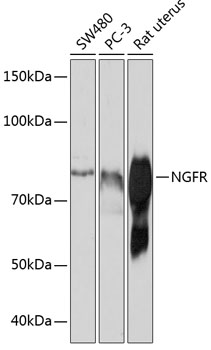Anti-NGFR Antibody (CAB19088)
- SKU:
- CAB19088
- Product type:
- Antibody
- Reactivity:
- Human
- Reactivity:
- Mouse
- Reactivity:
- Rat
- Host Species:
- Rabbit
- Isotype:
- IgG
- Research Area:
- Cell Death
Description
| 抗体名: | Anti-NGFR Antibody |
| 抗体コード: | CAB19088 |
| 抗体サイズ: | 20uL, 50uL, 100uL |
| 申し込み: | WB IHC |
| 反応性: | Human, Mouse, Rat |
| 宿主種: | Rabbit |
| 免疫原: | A synthesized peptide derived from human p75 NGF Receptor |
| 申し込み: | WB IHC |
| 推奨希釈: | WB 1:500 - 1:2000 IHC 1:50 - 1:200 |
| 反応性: | Human, Mouse, Rat |
| ポジティブサンプル: | SW480, PC-3, Rat uterus, Mouse brain, Mouse testis |
| 免疫原: | A synthesized peptide derived from human p75 NGF Receptor |
| 精製方法: | Affinity purification |
| ストレージバッファ: | Store at -20°C. Avoid freeze / thaw cycles. Buffer: PBS with 0.02% sodium azide, 0.05% BSA, 50% glycerol, pH7.3. |
| アイソタイプ: | IgG |
| 順序: | Email for sequence |
| 遺伝子ID: | 4804 |
| Uniprot: | P08138 |
| セルラーロケーション: | |
| 計算された分子量: | 75kDa |
| 観察された分子量: | 75kDa |
| 同義語: | CD271, Gp80-LNGFR, TNFRSF16, p75(NTR), p75NTR, NGFR |
| バックグラウンド: | Nerve growth factor receptor contains an extracellular domain containing four 40-amino acid repeats with 6 cysteine residues at conserved positions followed by a serine/threonine-rich region, a single transmembrane domain, and a 155-amino acid cytoplasmic domain. The cysteine-rich region contains the nerve growth factor binding domain. [provided by RefSeq, Jul 2008] |
| UniProt Protein Function: | NGFR: Low affinity receptor which can bind to NGF, BDNF, NT-3, and NT-4. Can mediate cell survival as well as cell death of neural cells. Homodimer; disulfide-linked. Interacts with p75NTR- associated cell death executor. Interacts with TRAF2, TRAF4, TRAF6, PTPN13 and RANBP9. Interacts through TRAF6 with SQSTM1 which bridges NGFR to NTRK1. Interacts with BEX1 and NGFRAP1/BEX3. Interacts with KIDINS220 and NTRK1. Can form a ternary complex with NTRK1 and KIDINS220 and this complex is affected by the expression levels of KIDINS220. An increase in KIDINS220 expression leads to a decreased association of NGFR and NTRK1. Interacts with NTRK2; may regulate the ligand specificity of the NTRK2 receptor. Interacts with LINGO1. |
| UniProt Protein Details: | Protein type:Receptor, misc.; Membrane protein, integral Chromosomal Location of Human Ortholog: 17q21-q22 Cellular Component: cell surface; clathrin-coated endocytic vesicle; cytosol; endosome; external side of plasma membrane; extracellular region; Golgi apparatus; integral to plasma membrane; lipid raft; neuron projection; nuclear envelope; nucleoplasm; nucleus; perikaryon; plasma membrane; rough endoplasmic reticulum Molecular Function:beta-amyloid binding; nerve growth factor binding; neurotrophin TRKA receptor binding; protein binding; Rab GTPase binding; receptor activity; signal transducer activity; transmembrane receptor activity; tumor necrosis factor receptor activity; ubiquitin protein ligase binding Biological Process: axon guidance; central nervous system development; circadian regulation of gene expression; detection of temperature stimulus; glucose homeostasis; hair follicle morphogenesis; immune response; inflammatory response; intracellular protein transport; membrane protein intracellular domain proteolysis; negative regulation of apoptosis; negative regulation of axonogenesis; negative regulation of cell cycle; negative regulation of fibroblast growth factor receptor signaling pathway; negative regulation of hair follicle development; negative regulation of mitochondrial depolarization; negative regulation of neuron apoptosis; nerve development; nerve growth factor receptor signaling pathway; positive regulation of apoptosis; positive regulation of axonogenesis; positive regulation of fibroblast proliferation; positive regulation of MAPKKK cascade; positive regulation of myelination; positive regulation of odontogenesis of dentine-containing teeth; positive regulation of protein kinase B signaling cascade; positive regulation of Rho protein signal transduction; positive regulation of synaptic transmission, cholinergic; positive regulation of synaptic transmission, glutamatergic; regulation of apoptosis; regulation of axonogenesis; regulation of caspase activity; regulation of cell proliferation; response to lipopolysaccharide; response to wounding; sensory perception of pain; tumor necrosis factor-mediated signaling pathway |
| NCBI Summary: | Nerve growth factor receptor contains an extracellular domain containing four 40-amino acid repeats with 6 cysteine residues at conserved positions followed by a serine/threonine-rich region, a single transmembrane domain, and a 155-amino acid cytoplasmic domain. The cysteine-rich region contains the nerve growth factor binding domain. [provided by RefSeq, Jul 2008] |
| UniProt Code: | P08138 |
| NCBI GenInfo Identifier: | 128156 |
| NCBI Gene ID: | 4804 |
| NCBI Accession: | P08138.1 |
| UniProt Secondary Accession: | P08138,B2R961, B4E096, |
| UniProt Related Accession: | P08138 |
| Molecular Weight: | 35,767 Da |
| NCBI Full Name: | Tumor necrosis factor receptor superfamily member 16 |
| NCBI Synonym Full Names: | nerve growth factor receptor |
| NCBI Official Symbol: | NGFR |
| NCBI Official Synonym Symbols: | CD271; p75NTR; TNFRSF16; p75(NTR); Gp80-LNGFR |
| NCBI Protein Information: | tumor necrosis factor receptor superfamily member 16 |
| UniProt Protein Name: | Tumor necrosis factor receptor superfamily member 16 |
| UniProt Synonym Protein Names: | Gp80-LNGFR; Low affinity neurotrophin receptor p75NTR; Low-affinity nerve growth factor receptor; NGF receptor; p75 ICD; CD_antigen: CD271 |
| Protein Family: | Tumor necrosis factor receptor superfamily |
| UniProt Gene Name: | NGFR |
| UniProt Entry Name: | TNR16_HUMAN |


